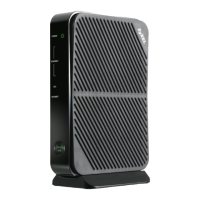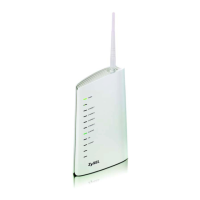Chapter 14 Certificates
P-79X Series User’s Guide
155
14.3 Certificates Technical Reference
This section provides technical background information about the topics covered in this chapter.
14.3.1 Certificates Overview
The P-79X can use certificates (also called digital IDs) to authenticate users. Certificates are based
on public-private key pairs. A certificate contains the certificate owner’s identity and public key.
Certificates provide a way to exchange public keys for use in authentication.
The P-79X uses certificates based on public-key cryptology to authenticate users attempting to
establish a connection, not to encrypt the data that you send after establishing a connection. The
Signature Algorithm This field displays the type of algorithm that was used to sign the certificate.
Some certification authorities use rsa-pkcs1-sha1 (RSA public-private key
encryption algorithm and the SHA1 hash algorithm). Other certification
authorities may use rsa-pkcs1-md5 (RSA public-private key encryption
algorithm and the MD5 hash algorithm).
Valid From This field displays the date that the certificate becomes applicable. The text
displays in red and includes a Not Yet Valid! message if the certificate has not
yet become applicable.
Valid To This field displays the date that the certificate expires. The text displays in red
and includes an Expiring! or Expired! message if the certificate is about to
expire or has already expired.
Key Algorithm This field displays the type of algorithm that was used to generate the
certificate’s key pair (the P-79X uses RSA encryption) and the length of the
key set in bits (1024 bits for example).
MD5 Fingerprint This is the certificate’s message digest that the P-79X calculated using the
MD5 algorithm. You can use this value to verify with the certification authority
(over the phone for example) that this is actually their certificate.
SHA1 Fingerprint This is the certificate’s message digest that the P-79X calculated using the
SHA1 algorithm. You can use this value to verify with the certification authority
(over the phone for example) that this is actually their certificate.
Certificate in PEM
(Base-64) Encoded
Format
This read-only text box displays the certificate or certification request in
Privacy Enhanced Mail (PEM) format. PEM uses 64 ASCII characters to convert
the binary certificate into a printable form.
You can copy and paste the certificate into an e-mail to send to friends or
colleagues or you can copy and paste the certificate into a text editor and save
the file on a management computer for later distribution (via floppy disk for
example).
Back Click this to return to the previous screen without saving.
Export Click this and then Save in the File Download screen. The Save As screen
opens, browse to the location that you want to use and click Save.
Apply Click this to save your changes. You can only change the name and/or set
whether or not you want the P-79X to check the CRL that the certification
authority issues before trusting a certificate issued by the certification
authority.
Cancel Click this to restore your previously saved settings.
Table 61 Trusted CA Details (continued)
LABEL DESCRIPTION

